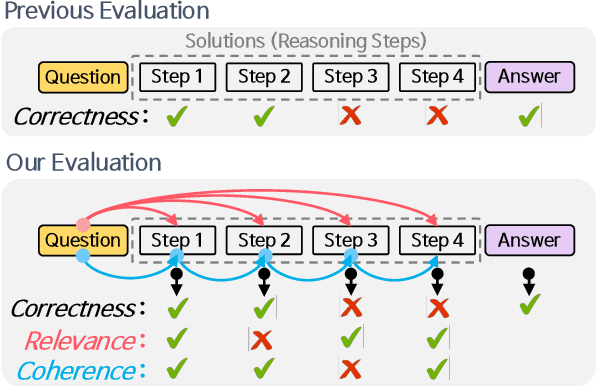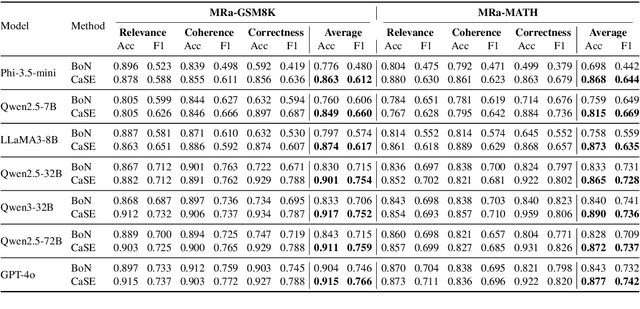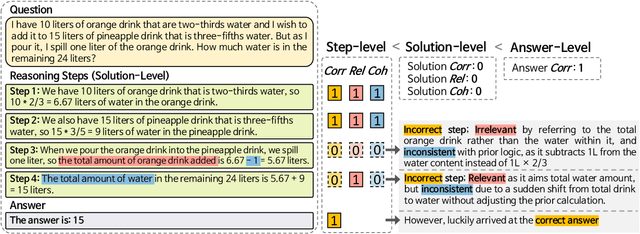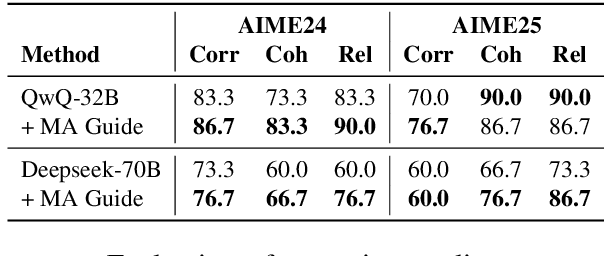Dongyoon Han
What Defines Good Reasoning in LLMs? Dissecting Reasoning Steps with Multi-Aspect Evaluation
Oct 23, 2025



Abstract:Evaluating large language models (LLMs) on final-answer correctness is the dominant paradigm. This approach, however, provides a coarse signal for model improvement and overlooks the quality of the underlying reasoning process. We argue that a more granular evaluation of reasoning offers a more effective path to building robust models. We decompose reasoning quality into two dimensions: relevance and coherence. Relevance measures if a step is grounded in the problem; coherence measures if it follows logically from prior steps. To measure these aspects reliably, we introduce causal stepwise evaluation (CaSE). This method assesses each reasoning step using only its preceding context, which avoids hindsight bias. We validate CaSE against human judgments on our new expert-annotated benchmarks, MRa-GSM8K and MRa-MATH. More importantly, we show that curating training data with CaSE-evaluated relevance and coherence directly improves final task performance. Our work provides a scalable framework for analyzing, debugging, and improving LLM reasoning, demonstrating the practical value of moving beyond validity checks.
Revisiting Reliability in the Reasoning-based Pose Estimation Benchmark
Jul 17, 2025Abstract:The reasoning-based pose estimation (RPE) benchmark has emerged as a widely adopted evaluation standard for pose-aware multimodal large language models (MLLMs). Despite its significance, we identified critical reproducibility and benchmark-quality issues that hinder fair and consistent quantitative evaluations. Most notably, the benchmark utilizes different image indices from those of the original 3DPW dataset, forcing researchers into tedious and error-prone manual matching processes to obtain accurate ground-truth (GT) annotations for quantitative metrics (\eg, MPJPE, PA-MPJPE). Furthermore, our analysis reveals several inherent benchmark-quality limitations, including significant image redundancy, scenario imbalance, overly simplistic poses, and ambiguous textual descriptions, collectively undermining reliable evaluations across diverse scenarios. To alleviate manual effort and enhance reproducibility, we carefully refined the GT annotations through meticulous visual matching and publicly release these refined annotations as an open-source resource, thereby promoting consistent quantitative evaluations and facilitating future advancements in human pose-aware multimodal reasoning.
Token Bottleneck: One Token to Remember Dynamics
Jul 09, 2025Abstract:Deriving compact and temporally aware visual representations from dynamic scenes is essential for successful execution of sequential scene understanding tasks such as visual tracking and robotic manipulation. In this paper, we introduce Token Bottleneck (ToBo), a simple yet intuitive self-supervised learning pipeline that squeezes a scene into a bottleneck token and predicts the subsequent scene using minimal patches as hints. The ToBo pipeline facilitates the learning of sequential scene representations by conservatively encoding the reference scene into a compact bottleneck token during the squeeze step. In the expansion step, we guide the model to capture temporal dynamics by predicting the target scene using the bottleneck token along with few target patches as hints. This design encourages the vision backbone to embed temporal dependencies, thereby enabling understanding of dynamic transitions across scenes. Extensive experiments in diverse sequential tasks, including video label propagation and robot manipulation in simulated environments demonstrate the superiority of ToBo over baselines. Moreover, deploying our pre-trained model on physical robots confirms its robustness and effectiveness in real-world environments. We further validate the scalability of ToBo across different model scales.
Aligned Novel View Image and Geometry Synthesis via Cross-modal Attention Instillation
Jun 13, 2025Abstract:We introduce a diffusion-based framework that performs aligned novel view image and geometry generation via a warping-and-inpainting methodology. Unlike prior methods that require dense posed images or pose-embedded generative models limited to in-domain views, our method leverages off-the-shelf geometry predictors to predict partial geometries viewed from reference images, and formulates novel-view synthesis as an inpainting task for both image and geometry. To ensure accurate alignment between generated images and geometry, we propose cross-modal attention distillation, where attention maps from the image diffusion branch are injected into a parallel geometry diffusion branch during both training and inference. This multi-task approach achieves synergistic effects, facilitating geometrically robust image synthesis as well as well-defined geometry prediction. We further introduce proximity-based mesh conditioning to integrate depth and normal cues, interpolating between point cloud and filtering erroneously predicted geometry from influencing the generation process. Empirically, our method achieves high-fidelity extrapolative view synthesis on both image and geometry across a range of unseen scenes, delivers competitive reconstruction quality under interpolation settings, and produces geometrically aligned colored point clouds for comprehensive 3D completion. Project page is available at https://cvlab-kaist.github.io/MoAI.
Diffusion Meets Few-shot Class Incremental Learning
Mar 30, 2025Abstract:Few-shot class-incremental learning (FSCIL) is challenging due to extremely limited training data; while aiming to reduce catastrophic forgetting and learn new information. We propose Diffusion-FSCIL, a novel approach that employs a text-to-image diffusion model as a frozen backbone. Our conjecture is that FSCIL can be tackled using a large generative model's capabilities benefiting from 1) generation ability via large-scale pre-training; 2) multi-scale representation; 3) representational flexibility through the text encoder. To maximize the representation capability, we propose to extract multiple complementary diffusion features to play roles as latent replay with slight support from feature distillation for preventing generative biases. Our framework realizes efficiency through 1) using a frozen backbone; 2) minimal trainable components; 3) batch processing of multiple feature extractions. Extensive experiments on CUB-200, miniImageNet, and CIFAR-100 show that Diffusion-FSCIL surpasses state-of-the-art methods, preserving performance on previously learned classes and adapting effectively to new ones.
DNNs May Determine Major Properties of Their Outputs Early, with Timing Possibly Driven by Bias
Feb 12, 2025Abstract:This paper argues that deep neural networks (DNNs) mostly determine their outputs during the early stages of inference, where biases inherent in the model play a crucial role in shaping this process. We draw a parallel between this phenomenon and human decision-making, which often relies on fast, intuitive heuristics. Using diffusion models (DMs) as a case study, we demonstrate that DNNs often make early-stage decision-making influenced by the type and extent of bias in their design and training. Our findings offer a new perspective on bias mitigation, efficient inference, and the interpretation of machine learning systems. By identifying the temporal dynamics of decision-making in DNNs, this paper aims to inspire further discussion and research within the machine learning community.
Peri-LN: Revisiting Layer Normalization in the Transformer Architecture
Feb 04, 2025



Abstract:Designing Transformer architectures with the optimal layer normalization (LN) strategy that ensures large-scale training stability and expedite convergence has remained elusive, even in this era of large language models (LLMs). To this end, we present a comprehensive analytical foundation for understanding how different LN strategies influence training dynamics in large-scale Transformer training. Until recently, Pre-LN and Post-LN have long dominated standard practices despite their limitations in large-scale training. However, several open-source large-scale models have recently begun silently adopting a third strategy without much explanation. This strategy places layer normalization (LN) peripherally around sublayers, a design we term Peri-LN. While Peri-LN has demonstrated promising empirical performance, its precise mechanisms and benefits remain almost unexplored. Our in-depth analysis shows that Peri-LN strikes an ideal balance in variance growth -- unlike Pre-LN and Post-LN, which are prone to vanishing gradients and ``massive activations.'' To validate our theoretical insight, we conduct large-scale experiments on Transformers up to 3.2B parameters, showing that Peri-LN consistently achieves more balanced variance growth, steadier gradient flow, and convergence stability. Our results suggest that Peri-LN warrants broader consideration for large-scale Transformer architectures, providing renewed insights into the optimal placement and application of LN.
Tint Your Models Task-wise for Improved Multi-task Model Merging
Dec 26, 2024



Abstract:Traditional model merging methods for multi-task learning (MTL) address task conflicts with straightforward strategies such as weight averaging, sign consensus, or minimal test-time adjustments. This presumably counts on the assumption that a merged encoder still retains abundant task knowledge from individual encoders, implying that its shared representation is sufficiently general across tasks. However, our insight is that adding just a single trainable task-specific layer further can bring striking performance gains, as demonstrated by our pilot study. Motivated by this finding, we propose Model Tinting, a new test-time approach that introduces a single task-specific layer for each task as trainable adjustments. Our method jointly trains merging coefficients and task-specific layers, which effectively reduces task conflicts with minimal additional costs. Additionally, we propose a sampling method that utilizes the difference in confidence levels of both merged and individual encoders. Extensive experiments demonstrate our method's effectiveness, which achieves state-of-the-art performance across both computer vision and natural language processing tasks and significantly surpasses prior works. Our code is available at https://github.com/AIM-SKKU/ModelTinting.
MaskRIS: Semantic Distortion-aware Data Augmentation for Referring Image Segmentation
Nov 28, 2024Abstract:Referring Image Segmentation (RIS) is an advanced vision-language task that involves identifying and segmenting objects within an image as described by free-form text descriptions. While previous studies focused on aligning visual and language features, exploring training techniques, such as data augmentation, remains underexplored. In this work, we explore effective data augmentation for RIS and propose a novel training framework called Masked Referring Image Segmentation (MaskRIS). We observe that the conventional image augmentations fall short of RIS, leading to performance degradation, while simple random masking significantly enhances the performance of RIS. MaskRIS uses both image and text masking, followed by Distortion-aware Contextual Learning (DCL) to fully exploit the benefits of the masking strategy. This approach can improve the model's robustness to occlusions, incomplete information, and various linguistic complexities, resulting in a significant performance improvement. Experiments demonstrate that MaskRIS can easily be applied to various RIS models, outperforming existing methods in both fully supervised and weakly supervised settings. Finally, MaskRIS achieves new state-of-the-art performance on RefCOCO, RefCOCO+, and RefCOCOg datasets. Code is available at https://github.com/naver-ai/maskris.
NegMerge: Consensual Weight Negation for Strong Machine Unlearning
Oct 08, 2024Abstract:Machine unlearning aims to selectively remove specific knowledge from a model. Current methods, such as task arithmetic, rely on fine-tuning models on the forget set, generating a task vector, and subtracting it from the original model. However, we argue the effectiveness of this approach is highly sensitive to hyperparameter selection, necessitating careful validation to identify the best model among many fine-tuned candidates. In this paper, we propose a novel method that leverages all given fine-tuned models rather than selecting a single one. By constructing task vectors from models trained with varied hyperparameters and merging only the components of the task vectors with consistent signs, we perform unlearning by negating the merged task vector from the original model. Given that existing methods also utilize multiple fine-tuned models, our approach delivers more effective unlearning without incurring additional computational costs. We demonstrate the effectiveness of our method on both vision-language models and standard image classification models, showing improved unlearning performance with minimal degradation on the retain set, outperforming state-of-the-art techniques.
 Add to Chrome
Add to Chrome Add to Firefox
Add to Firefox Add to Edge
Add to Edge